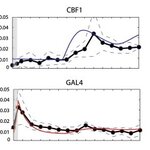Genetics & Molecular Biology

Many computational biologists are interested in taking gene expression data, and using that data to computationally infer the underlying regulatory network that controls the observed pattern of gene expression.
Why? Because doing the experiments to determine the structure of these regulatory networks is hard; if we could use more easily obtained data to reliably tease out the network structure, we'd be able to quickly characterize networks in unexplored cell types or in poorly studied microbes.
The problem when making these network-inferring algorithms is knowing whether you're getting the…

There's a perception among some that it's a man's world and they get all the attention. If you've ever been in a bar or a library or a baseball game, you know this is not true - have a woman drop a napkin and see what happens whereas a man could be bleeding out his eyes and be unnoticed. But women want to keep men on their toes by pretending they are in charge.
Now the gig may be up, thanks to biology.
University of California, Berkeley biologist Doris Bachtrog and her colleagues say that the history of the X chromosome offers important clues to the origins and…

A study of gene expression in chickens, frogs, pufferfish, mice and people has revealed surprising similarities in several key tissues. Researchers writing in BioMed Central's open access Journal of Biology have shown that expression in tissues with a limited number of specialized cell types is strongly conserved, even between the mammalian and non-mammalian vertebrates.
Timothy Hughes from the University of Toronto, Canada, worked with a team of researchers to investigate evolutionary alterations in gene regulation in the five different vertebrates. They found that although the specialized…

Genetic differences can influence one's risk of developing proteinuria, a condition that increases the risk of cardiovascular disease and chronic kidney disease (CKD), according to a study appearing in an upcoming issue of the Journal of the American Society of Nephrology (JASN). The results may be important for determining patients' health risks and for devising new medical treatments.
Approximately 12% of people in the United States have proteinuria (abnormal levels of protein lost in the urine), and African Americans and American Indians have higher risks of developing the condition than…

Researchers say they have uncovered new evidence suggesting factors other than genes could cause obesity, finding that genetically identical cells store widely differing amounts of fat depending on subtle variations in how cells process insulin. Findings indicate that the faster a cell processes insulin, the more fat it stores.
Learning the precise mechanism responsible for fat storage in cells could lead to methods for controlling obesity.
Other researchers have suggested that certain "fat genes" might be associated with excessive fat storage in cells. However, the Purdue…

In parallel human and mouse studies, two groups of researchers have come to the same conclusion: that a new kind of gene is associated with progressive hearing loss. The new gene, a microRNA, is a tiny fragment of RNA that affects the production of hundreds of other molecules within sensory hair cells of the inner ear. The research provides important new genetic understanding of a condition that is common in humans but remains poorly understood.
One team, led by researchers from the Hospital Ramón y Cajal, Madrid, Spain, followed families who showed hearing loss. The second team, led…

Researchers have reported that they have been able to determine the molecular structure of a plant photolyase protein that is surprisingly similar to two cryptochrome proteins that control the "master clock" in humans and other mammals. They have also been able to test how structural changes affect the function of these proteins.
"The plant photolyase structure provides a much better model to use to study how the cryptochrome proteins in the human clock function than we have ever had before," says the study's lead investigator, Kenichi Hitomi, Ph.D., a postdoctoral research fellow at Scripps…

A protein that the heart produces during its early development reactivates the embryonic coronary developmental program and initiates migration of heart cells and blood vessel growth after a heart attack, researchers at UT Southwestern Medical Center have found.The molecule, Thymosin beta-4 (TB4), is expressed by embryos during the heart's development and encourages migration of heart cells. The new findings in mice suggest that introducing TB4 systemically after a heart attack encourages new growth and repair of heart cells. The research findings indicate that the molecule affects…

The problem of how to model a biological system has been staring me in the face every day in recent months, and I need a place to indulge in baseless speculation. So if you stick around here at Adaptive Complexity for the next few weeks, you are going to get treated to a dose of half-baked, semi-coherent (at best), partially thought-out musings on what it takes to model a biological system.
I'll start with a story: after news of the post-9/11 anthrax attacks in the fall of 2001, an older colleague told me that he didn't think the attackers were very sophisticated bioengineers. "After all," he…

Males and females across many animal phyla are genetically separate in that they inherit different sets of sex chromosomes. As known, human females inherit two copies of X chromosomes while males inherit one X chromosome and one Y chromosome. The Y chromosome has very few genes but does carry the male determining gene that is expressed later in development. So do females have more genes expressed perhaps conveying their ability shop more and talk more? Not exactly. This genetic imbalance between the sexes is why dosage compensation evolved and different animal…